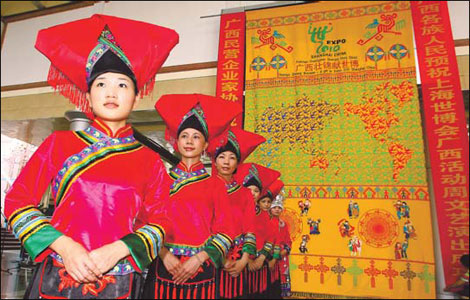Threads of history
In the inner room, even the facade of machine operation is gone. The loom is exactly the same as it was hundreds of years ago. Instead of a stack of cardboard, now we have a bamboo basket overhead that holds the single-color yarn. Besides the rugged look, it can weave a fabric of half a meter, about half the width as the "machine" kind.
Here, weavers sit instead of standing. They have a band that holds their waist. "This job not only strains the eyes, but is hard on the back," Huang says.
The brocade presented at the Shanghai Expo required six weavers to work simultaneously and at exactly the same speed. If one gets it wrong, everyone has to go back to the same place to fix it.
"All this was done in a workshop with no air-conditioning," says Tan Xiangguang, who led the project in a 12-hour-a-day weaving marathon.
Tan, 55, started her weaving career at the age of 16. "We had to cooperate as if were just one person," she says. "Traditional yarn looks coarse and easily breaks when used as the longitudinal thread. This time we used something stronger and more refined, and it yielded a pattern that is smoother."
Tan wants to use this seamless brocade to bring the world's attention to her hometown and to have more people love this unique form of ethnic craft. In ancient times, the local legend goes, it was a fairy goddess who discovered the beauty of Zhuang embroidery: There was a Zhuang family of a mother and her three sons. The mother was a skillful weaver. She was working on a brocade with a house, a garden, an orchard, some farmland and some farm animals.
A gale swept the brocade away. It turned out the fairy goddess wanted to learn the craft of Zhuang embroidery. The mother dispatched her sons, one by one, to search for it. Both the eldest son and the second son ended up taking trips elsewhere and forgot their mission. The youngest son endured highs and lows and finally found the fairy goddess in a red dress. She was imitating the pattern of the embroidery and was not ready to return it. The son snatched it away and rode home.
Unbeknownst to him, the goddess had woven her own image into his mother's work. When he arrived home, the landscape in the pattern grew larger and larger, turning into a life-size farmland with all the images becoming real. That included the red-dressed fairy goddess. And she and the youngest son wed, living a life of rustic happiness ever after.
Many visitors to the Shanghai Expo who get a glimpse of this tapestry will surely fall in love with Guangxi, its people, its crafts and its landscape.
Huang Zhaohua and Zheng Yan contributed to this story.
 |
| The largest Zhuang embroidery of its kind is on display at the Shanghai Expo, incorporating images of a dove and a world map. |
 0
0 







Go to Forum >>0 Comments